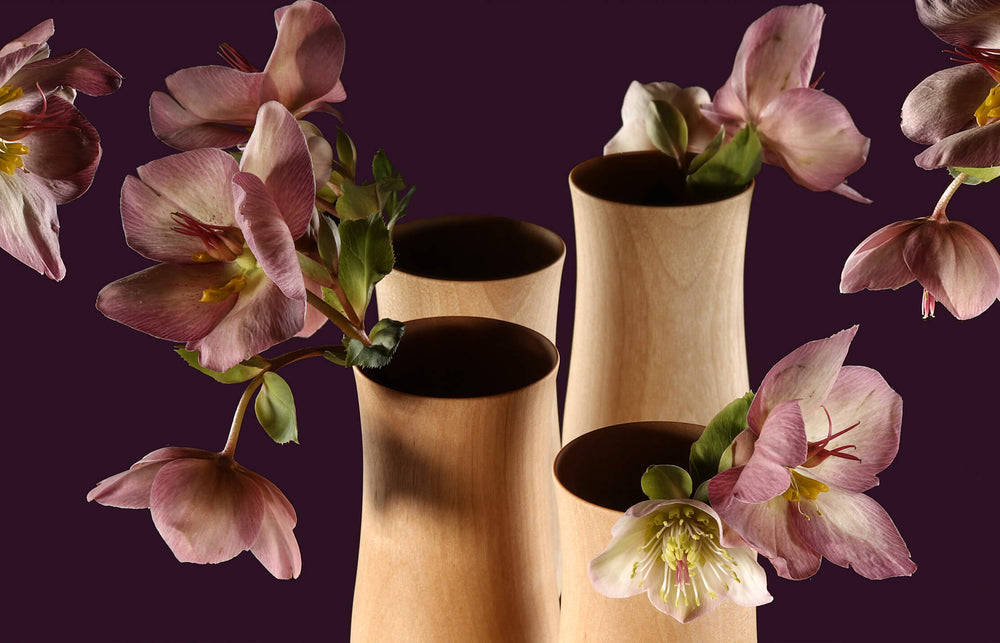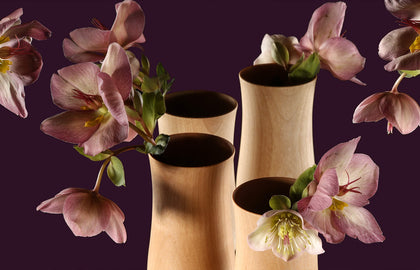
Interview with Terry Widner of Spoontaneous - Part One
We’re excited to post our first Eatingtools artist interview with Terry Widner, of Spoontaneous, sharing the magic and inspiration behind his one-of-a-kind wooden spoons. We had the pleasure of meeting up with Terry down in Florida this past December. Here he is on the art of the wooden spoon—but not your average wooden spoon.
 Terry Widner and Abe Shaw meet in South Florida
Terry Widner and Abe Shaw meet in South Florida
Your designs are unique, to say the least. Having made quite a few spoons, at this point your portfolio is quite eclectic, and we might go as far as to describe it as eccentric, in the best way possible! So, how did you come to make spoons?
Before 2009 I had made only one wooden spoon. Mostly I made a variety of wooden objects including boxes, walking canes, decorative bowls, marquetry panels, and a variety of small sculptures and carvings.
I had so many ideas of things I wanted to make that the creative process would become bottle-necked. I'd make a couple of pieces, and it might be a year or two before making something else—a sort of creative paralysis.
In 2009 I was inspired by the beautiful spoon work of Norm Sartorius and decided I would focus on carving sculptural spoons for a spell. I think this sort of focus was exactly what I needed to release the bottleneck. The wooden spoon, with its limitless design possibilities, serves as the perfect canvas for creativity.
 Leaf Spoon
Leaf Spoon
What inspires you? Do you start with an idea for a spoon and then obtain your material, or do you take a different approach? Share some insights into your creative process with us.
Hey, wait a minute. That's two questions. What inspires me? Just about everything. Music, words and phrases, nature, humor, the shape of an oil spot on the pavement, artists and craftsmen in other mediums, and sometimes it comes from misinterpreting what I think I see (sort of like seeing faces in the wood grain).
Do I start with an idea? A great question, but a difficult one to give a definitive (or brief) answer to. Many times the process does begin with an idea. I have a stack of sketchbooks that are full of spoon doodles. Some of those sketches are very defined and figurative, while others only vaguely resemble what is normally considered a spoon shape.
In the case of the more figurative concepts, I look for a suitable piece of wood that might complement the design. Sometimes that search for a suitable piece of wood can be quite frustrating. Down here in South Florida we don't have a lot of the familiar “up north” hardwoods, and the prices of exotic woods have been sorely inflated by the demand of woodturners.
Sometimes it is a dominant feature of a particular piece of wood that influences (or even dictates) the design of the spoon. This feature can be an area of beautiful grain, a limb scar or knot where the wood was damaged, insect damage, interesting bark, and the such.
Some pieces of wood are propped up on the work bench for months before I “see what's in there.” Such was the case of Fraternal Twins, which came from a piece of bi-colored figured walnut. I couldn't see anything at all for many months, and then one day there it was! How did I not see it before?
 Fraternal Twins
Fraternal Twins
There are also times when the spoon is so obvious in a piece of wood that no other design possibility presents itself. This is especially true with the more natural pieces. The Wizard's Spoon I found while hiking in the woods near Franklin, TN. As I was walking past the upturned roots on a tree that had been blown over by the wind, I noticed this one twisty root that had spoon handle written all over it. All I had to do was carve a bowl into it. A friend stopped by just as I finished it, and he exclaimed, “Oh look, a Wizard's Spoon.” And not until then did I see that's what it was.
 Wizard's Spoon
Wizard's Spoon
But here is the reason why it is difficult to answer this question with clarity: Not one single spoon I have ever made turned out the way I intended or envisioned. Never happens! Part of that is my lack of skill to pull such a thing off, but most of the reason is that something else takes over during the carving process.
One of the first spoons I carved started as a pruned branch from a friend's grapefruit tree which was dying due to some blight. This forked piece of wood looked like a frog with its legs extended and was destined to be a “frog spoon,” but the next morning when I picked it up it was no longer a frog. Overnight the dang thing had turned into a rabbit head, and the legs had become ears. Thus, the Eater Bunny was born.
 Eater Bunny
Eater Bunny
I decided one day that I would carve a spoon from a block of mahogany and only have the end of the handle and spoon bowl emerge from the block. My thinking was that I could carve half of a spoon, call it “art,” and charge for a whole spoon.
Once I carved into it that far, it didn't look like art at all, so I kept carving and ended up with Outside the Box, which had never entered my mind until the spoon was complete.
 Outside the Box
Outside the Box
But most times it is not quite that defined. I will be carving and I sort of zone out (or maybe it is zoning in), and the carving process continues without me. I will sort of come aware, like that feeling you get when you've been driving for a while and all of a sudden you realize that you were on automatic and have no idea how you got to where you are. Something other than the conscious mind is running things.
In fact, I have written down on an index card, “Art is not something you do, it is something you allow to happen.” I think maybe my mind is weak enough to get out of the way—sometimes.
 Cedar Arch
Cedar Arch
And then some other times, a certain kind of “magic” happens. I become aware during those zoned out times, and I can watch in a detached way what is occurring, even chuckling at the humor in a piece, as I am seeing it for the first time. This is what drags me back to the shop.
Most of your spoons are not functional, or as you say “dysfunctional.” Others are more straightforward. Is a spoon still a spoon if it cannot spoon food?
According to history it is. Many ancient cultures are known to have carved and used wooden spoons purely for ceremonial purposes, religious and otherwise. Centuries ago the Egyptians carved elaborate cosmetic spoons (also known as “offering spoons”) which they reportedly used to throw myrrh into the fire as an offering to their gods.
In Wales there has been a tradition dating back hundreds of years where the male suitors would carve a “lovespoon” with intricately detailed handles for their young brides-to-be. Instead of being put into food service, these spoons were usually hung on the walls for decoration.
Decorative spoons have been around longer than we have, so I suppose they still qualify as spoons. They do lend themselves to collecting. They are relatively small and affordable, and the variety from many contemporary spoon makers is astounding. Examples of decorative wooden spoons (contemporary and antique) can be found in many art museums.
 Dieter's Spoon
Dieter's Spoon
Humor is a theme throughout your work. What role does humor play in art?
I really enjoy it when humor shows up in my art. It just makes the whole process more fun.
As for the role of humor in art, I see it as one of those elements that adds richness and depth. It seems any facet of our lives can be expressed in art, whether it is humor, or sadness, or fear—or joy, love, compassion, and even tragedy.
What I like about humor in art is that it seems to elicit a certain response from the viewer that might give them cause to smile. And while I don't claim to know much about “art” in general, what I do find myself attracted to are those pieces that I respond to in some way. In that sense, I suppose this might qualify “art” as functional.
 Sumo
Sumo
Read more from Terry on his tools and techniques, plus more stories behind the spoons in PART TWO.
Shop Terry's work Here.

















